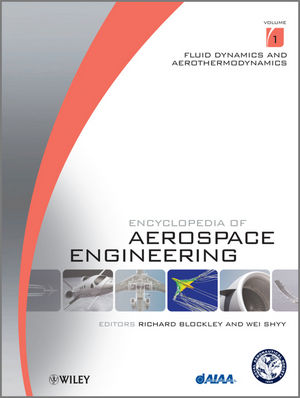Encyclopedia of Aerospace Engineering, 9 Volume SetISBN: 978-0-470-75440-5
Hardcover
5810 pages
December 2010
 |
||||||
Connect with Wiley Publicity
“A milestone and marker in the continuing development of aerospace engineering and science at the beginning of the second century of manned,
powered flight and as the promise of space seems increasingly resurgent. We are proud, jointly, to commend it to you.” from the Foreword by Dr Mark Lewis, President, American Institute of Aeronautics and Astronautics, USA and Dr Michael Steeden, President, 2009-2010, Royal Aeronautical Society, UK
Wiley is proud to publish the landmark reference on the science and technology of flight, in print and online formats. The Encyclopedia of Aerospace Engineering (October 2010) represents a major publishing initiative to establish a high quality, carefully coordinated reference work that will enhance education, training and research in this complex and demanding field.
Aerospace engineering must respond continually to new commercial, environmental and security-related factors, rapid advances in science and engineering, and the technological challenges of previously unexplored aircraft design concepts, and space-based systems and travel. The products of aerospace engineering are the result of a complex synthesis of multidisciplinary technologies and sciences.
The Encyclopedia of Aerospace Engineering is the first large-scale reference work to address the entire range of engineering and scientific principles of air- and spacecraft design, construction and operation. It provides an unparalleled exposition of essential scientific concepts and their application to current engineering practice, laying a foundation for further research and study in specialist publications. Extensive and up-to-date cross-referencing enhances the value of this monumental work and will ensure its unique contribution to the engineering literature.
The subject coverage was planned and developed by an international team of over 70 editors and advisers drawn from academic, industrial and military centers of excellence. The nine themed volumes encompass 43 subject classifications, and comprise nearly 500 articles with contributions from more than 600 experts.
The Encyclopedia of Aerospace Engineering is intended for Aerospace Manufacturers and Suppliers, Aerospace and Air Force Research Establishments, Airline and Aviation Industries, and Safety and Environmental Authorities. It is also intended for Senior Undergraduate and Postgraduate level Students and Researchers in University Engineering and Science Departments, as well as Industry Analysts, Consultants and Researchers.
CONTENTS
Volume 1: Fluid Dynamics and Aerothermodynamics. Perspectives on Aerospace Engineering; Fundamentals of Fluid Flows; Incompressible Flows and Aerodynamics; Compressible Flows -- Subsonic to Supersonic; Hypersonics and Rarefied Gas Dynamics; Heat Transfer and Thermophysics; Computational Fluid Dynamics; Experimental Techniques for Fluid Dynamics and Thermal Science.
Volume 2. Propulsion and Power. Basic Concepts; Airbreathing Engines; Rocket Propulsion; Alternative Propulsion.
Volume 3: Structural Technology. Structural Mechanics; Aeroelasticity and Aeroservoelasticity; Computational Solid Mechanics and Fluid-Structure Interaction; Experimental Techniques for Structural Mechanics; Structural Health Monitoring (SHM).
Volume 4: Materials Technology. Structural Materials; High Temperature Materials; Active Materials; Materials for Space Applications.
Volume 5: Dynamics and Control. Flight Mechanics; Flight Control; Radar; Trajectory and orbital Mechanics; Attitude Dynamics and Orbital Control of Spacecraft.
Volume 6: Environmental Impact, Manufacturing and Operations. Operational Environment; Acoustics and Noise; Emissions and Atmospheric Impact; Disposal and Waste Mitigation; Manufacturing, Lean Technologies and Operations Integration.
Volume 7: Vehicle Design. Vehicle Configurations and Performance; Air Vehicle Design; Micro Air Vehicles; Space Vehicles and Travel; Survivability.
Volume 8: System Engineering. Project Management; Avionics System Integration; Aircraft Sub-Systems; System Integration; Propulsion Integration; Optimization Techniques and Applications; Safety Engineering and Mission Assurance.
Volume 9: Index



